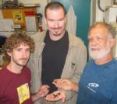(Press-News.org) (Santa Barbara, Calif.) –– Scientists at UC Santa Barbara have discovered a caste of genetically identical "warrior worms" –– members of a parasitic fluke species that invades the California horn snail. The findings are reported in the early online version of the Proceedings of the Royal Society B.
"We have discovered flatworms in colonies with vicious, killer morphs defending the colony," said Armand M. Kuris, professor of zoology, in the Department of Ecology, Evolution and Marine Biology. "These flukes have a strongly developed social organization, much like some insects, mammals and birds." The tiny warrior worms are only a couple of millimeters in length, yet they are powerful thanks to relatively large mouths.
These worms form colonies in snails. Reproductive worms and soldier worms cooperate to grow and defend their colony within the snail. These two types of individuals look and behave differently, explained first author Ryan F. Hechinger, assistant research biologist with UCSB's Marine Science Institute. The warrior worms attack other invasive parasites trying to invade the snail.
Kuris calls the worms parasitic "body snatchers," because they castrate the snail, making it unable to reproduce. The snail, which is only an inch and a half long, houses thousands of worms. A mature colony of this type of worm weighs 25 percent of the weight of the host snail.
The worms are produced through asexual reproduction and their relationships are even more dramatic than those among honeybees. For example, worker bees and queen bees are related as sisters through sexual reproduction. "The fluke castes described by our research team are genetically identical," said Hechinger. "They are clones."
Many other species of flukes probably have colonies of clones with castes, said Kuris. He expects international research to expand in this direction, now that this example has been discovered.
These colonies also act like an immune system, defending the body of the snail from other fluke infections, said second author Alan C. Wood, a marine science lab manager at UCSB. The soldiers behave like white blood cells; they attack other unrelated flukes, biting and killing them.
These flukes with soldier castes may also have a biomedical application. They might be used in the biological control of major human parasitic diseases such as blood flukes. There are 200 million cases of blood fluke diseases worldwide, said Kuris. The soldier worms might eliminate infections from forming in the snail hosts, preventing infections in humans. Liver flukes might also be controlled.
INFORMATION:
'Warrior worms' discovered in snails; UCSB scientists see possible biomedical applications
2010-09-16
ELSE PRESS RELEASES FROM THIS DATE:
Fish schools and krill swarms take on common shape
2010-09-16
When fish or tiny, shrimp-like krill get together, it appears they follow the same set of "rules." According to a new study published online on September 16th in Current Biology, a Cell Press publication, shoals of fish and swarms of krill hang out in groups that take on the same overall shape; it's not a simple sphere, a cylinder, or ovoid, but something more akin to an irregular crystal, the researchers say.
"The fact that several species of fish and krill that live in very different locations—from the tropics to polar oceans—form shoals that are the same shape suggests ...
Night lights affect songbirds' mating life
2010-09-16
In today's increasingly urbanized world, the lights in many places are always on, and according to a report published online on September 16 in of Current Biology, a Cell Press publication, that's having a real impact on the mating life of forest-breeding songbirds.
"In comparison to chemical and noise pollution, light pollution is more subtle, and its effects have perhaps not received the attention they deserve," said Bart Kempenaers of the Max Planck Institute for Ornithology in Germany. "Our findings show clearly that light pollution influences the timing of breeding ...
Brain matter linked to introspective thoughts
2010-09-16
VIDEO:
This is an informal conversation with Mr. Stephen Fleming . This video relates to an article that is appearing in the Sept. 17, 2010, issue of Science, published by AAAS....
Click here for more information.
A specific region of the brain appears to be larger in individuals who are good at turning their thoughts inward and reflecting upon their decisions, according to new research published in the journal Science. This act of introspection—or "thinking about your ...
Optical chip enables new approach to quantum computing
2010-09-16
An international research group led by scientists from the University of Bristol has developed a new approach to quantum computing that could soon be used to perform complex calculations that cannot be done by today's computers.
Scientists from Bristol's Centre for Quantum Photonics have developed a silicon chip that could be used to perform complex calculations and simulations using quantum particles in the near future. The researchers believe that their device represents a new route to a quantum computer – a powerful type of computer that uses quantum bits (qubits) ...
Moon's craters give new clues to early solar system bombardment
2010-09-16
PROVIDENCE, R.I. [Brown University] — Take a cursory look at the moon, and it can resemble a pockmarked golf ball. The dimples and divots on its surface are testament that our satellite has withstood a barrage of impacts from comets, asteroids and other space matter throughout much of its history. Because the geological record of that pummeling remains largely intact, scientists have leaned on the moon to reconstruct the chaotic early days of the inner solar system.
Now a team led by Brown University planetary geologists has produced the first uniform, comprehensive catalog ...
'Archeologists of the air' isolate pristine aerosol particles in the Amazon
2010-09-16
Cambridge, Mass. and Manaus, Brazil – September 16, 2010 – Environmental engineers who might better be called "archeologists of the air" have, for the first time, isolated aerosol particles in near pristine pre-industrial conditions.
Working in the remote Amazonian Basin north of Manaus, Brazil, the researchers measured particles emitted or formed within the rainforest ecosystem that are relatively free from the influence of anthropogenic, or human, activity.
The finding, published in the September 16 issue of Science, could provide crucial clues to understanding cloud ...
MIT researchers discover an unexpected twist in cancer metabolism
2010-09-16
CAMBRIDGE, Mass. -- In a paper appearing in the Sept. 16 online edition of Science, Matthew Vander Heiden assistant professor of biology and member of the David H. Koch Institute for Integrative Cancer Research at MIT and researchers at Harvard University report a previously unknown element of cancer cells' peculiar metabolism. They found that cells can trigger an alternative biochemical pathway that speeds up their metabolism and diverts the byproducts to construct new cells.
The finding could help scientists design drugs that block cancer-cell metabolism, essentially ...
Foraging for fat: Crafty crows use tools to fish for nutritious morsels
2010-09-16
Tool use is so rare in the animal kingdom that it was once believed to be a uniquely human trait. While it is now known that some non-human animal species can use tools for foraging, the rarity of this behaviour remains a puzzle. It is generally assumed that tool use played a key role in human evolution, so understanding this behaviour's ecological context, and its evolutionary roots, is of major scientific interest. A project led by researchers from the Universities of Oxford and Exeter examined the ecological significance of tool use in New Caledonian crows, a species ...
Optimizing climate change reduction
2010-09-16
Palo Alto, CA—Scientists at the Carnegie Institution's Department of Global Ecology have taken a new approach on examining a proposal to fix the warming planet. So-called geoengineering ideas—large-scale projects to change the Earth's climate—have included erecting giant mirrors in space to reflect solar radiation, injecting aerosols of sulfate into the stratosphere making a global sunshade, and much more. Past modeling of the sulfate idea looked at how the stratospheric aerosols might affect Earth's climate and chemistry. The Carnegie researchers started out differently ...
Imbalanced diet and inadequate exercise may underlie asthma in children
2010-09-16
Even children of a healthy weight who have an imbalanced metabolism due to poor diet or exercise may be at increased risk of asthma, according to new research, which challenges the widespread assumption that obesity itself is a risk factor for asthma.
"Our research showed that early abnormalities in lipid and/or glucose metabolism may be associated to the development of asthma in childhood," said lead author Giovanni Piedimonte, M.D., who is professor and chairman of the Department of Pediatrics at West Virginia University School of Medicine, physician-in-chief at WVU ...






